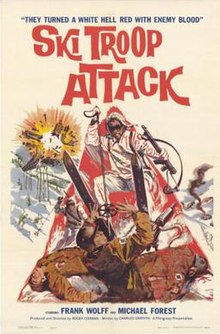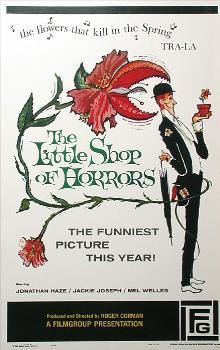
The Little Shop of Horrors is a 1960 American horror comedy film directed by Roger Corman. Written by Charles B. Griffith, the film is a farce about a florist's assistant who cultivates a plant that feeds on human blood. The film's concept may have been inspired by "Green Thoughts", a 1932 story by John Collier about a man-eating plant. Hollywood writer Dennis McDougal suggests that Griffith may have been influenced by Arthur C. Clarke's 1956 science fiction short story "The Reluctant Orchid".

Tobruk is a 1967 American drama war film directed by Arthur Hiller and starring Rock Hudson and George Peppard. The film was written by Leo Gordon and released through Universal Pictures.

The Wild Angels is a 1966 American independent outlaw biker film produced and directed by Roger Corman. Made on location in Southern California, The Wild Angels was the first film to associate actor Peter Fonda with Harley-Davidson motorcycles and 1960s counterculture. It inspired the biker film genre that continued into the early 1970s.
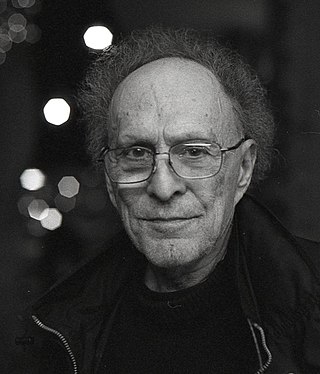
Monte Hellman was an American film director, producer, writer, and editor. Hellman began his career as an editor's apprentice at ABC TV, and made his directorial debut with the horror film Beast from Haunted Cave (1959), produced by Gene Corman, Roger Corman's brother.

Walter Frank Hermann Wolff was an American actor whose film career began with roles in five 1958–61 Roger Corman productions and ended a decade later in Rome, after many appearances in European-made films, most of which were lensed in Italy.
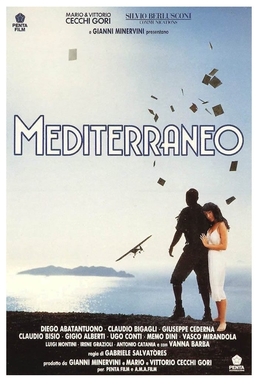
Mediterraneo is a 1991 Italian war comedy-drama film directed by Gabriele Salvatores and written by Enzo Monteleone. The film is set during World War II and concerns a group of Italian soldiers who become stranded on an island of the Italian Dodecanese in the Aegean Sea, and are left behind by the war. It won the Academy Award for Best Foreign Language Film in 1992.

The Lost Battalion is a 2001 American war drama television film about the US 77th Division's Lost Battalion during World War I, which was cut off and surrounded by German forces in the Argonne Forest during the Meuse-Argonne Offensive of 1918. The film was directed by Russell Mulcahy, written by James Carabatsos, and stars Rick Schroder as Major Charles Whittlesey. The film was shot in Luxembourg. It is an A&E Original Movie, premiering on the network on December 2, 2001. It is also played on A&E's sister networks such as The History Channel. It was released on home video in January 2002.

Creature from the Haunted Sea is a 1961 horror comedy movie directed by Roger Corman. Written by Charles B. Griffith, the movie is a parody of spy, gangster, and monster movies, concerning a secret agent, XK150, who uses the name "Sparks Moran" in order to infiltrate a criminal gang commanded by Renzo Capetto, who is trying to transport an exiled Cuban general with an entourage and a large portion of the Cuban treasury out of Cuba. Filmgroup released the movie as a double feature with Devil's Partner.

Beast from Haunted Cave is a 1959 horror/heist film directed by Monte Hellman and starring Michael Forest, Frank Wolff and Richard Sinatra. It was produced by Gene Corman, Roger Corman's brother. Filmed in South Dakota at the same time as Ski Troop Attack, it tells the story of bank robbers fleeing in the snow who run afoul of a giant spider-like monster that feeds on humans. The film was released as a double feature with The Wasp Woman (1959).
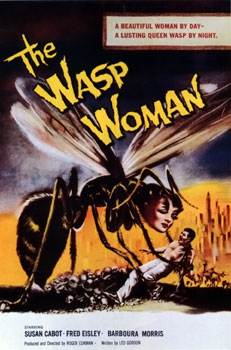
The Wasp Woman is a 1959 American independent science-fiction horror film produced and directed by Roger Corman. Filmed in black-and-white, it stars Susan Cabot, Anthony Eisley, Michael Mark, and Barboura Morris. The film was originally released by Filmgroup as a double feature with Beast from Haunted Cave. To pad out the film's running time when it was released to television two years later, a new prologue was added by director Jack Hill.

The Private Navy of Sgt. O'Farrell is a 1968 American comedy film directed by Frank Tashlin and starring Bob Hope, Phyllis Diller, and Jeffrey Hunter. It was the final film for Tashlin, who died in 1972.

None but the Brave is a 1965 epic anti-war film directed by Frank Sinatra, with special effects by Eiji Tsuburaya. Produced by Tokyo Eiga, Toho, and Sinatra Enterprises, it was the first film to be internationally co-produced between Japan and the United States.

The Hunt for Eagle One is a 2006 direct-to-video war film directed by Brian Clyde and produced by Roger Corman, starring Mark Dacascos, Theresa Randle, Ricardo Cepeda, Rutger Hauer, Joe Suba, and Zach McGowan. Set during Operation Enduring Freedom in the Philippines, the film follows a team of U.S. Marines who attempt to rescue a captured U.S. Marine Corps captain and an Armed Forces of the Philippines major, while tracking down a group of al-Qaeda terrorists intent on launching biological weapons.

Von Richthofen and Brown, alternatively titled The Red Baron, is a 1971 war film directed by Roger Corman and starring John Phillip Law and Don Stroud as Manfred von Richthofen and Roy Brown. Although names of real people are used and embedded in basic historic facts, the story by Joyce Hooper Corrington and John William Corrington makes no claim to be historically accurate, and in fact is largely fictional.

Highway Dragnet is a 1954 American film noir B film crime film directed by Nathan Juran from a story by U.S. Andersen and Roger Corman. The film stars Richard Conte, Joan Bennett and Wanda Hendrix. It was Roger Corman's first feature film credit. Corman also worked as an associate producer.
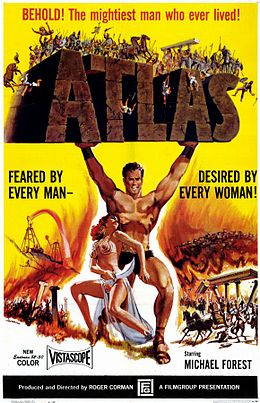
Atlas is a 1961 peplum film directed by Roger Corman and starring Michael Forest and Frank Wolff. It was filmed in Greece. Corman called it "my last attempt to do a big picture on a low budget." Writer Charles B. Griffith said "Atlas was a mess. It was a doomed project. "

Battle of Blood Island is a 1960 American World War II war film filmed in Puerto Rico and directed by Joel Rapp. It was based on the 1958 short story Expect the Vandals by Philip Roth. Filmgroup released the film, as a double feature with Ski Troop Attack.
Screaming Eagles is a 1956 American historical war film directed by Charles F. Haasd starring Tom Tryon, Jan Merlin and, in her film debut, French Miss Universe 1954 runner-up Jacqueline Beer. It was released by Allied Artists.
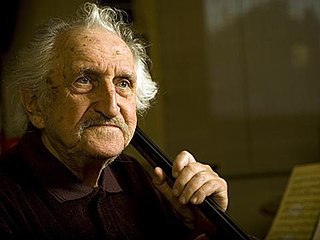
Frederick Katz was an American cellist and composer. He was among the earliest jazz musicians to establish the cello as a viable improvising solo instrument. Katz has been described in CODA magazine as "the first real jazz cellist."
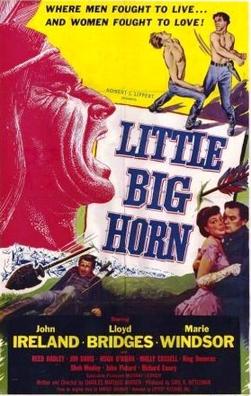
Little Big Horn is a 1951 American Western film written and directed by Charles Marquis Warren starring Lloyd Bridges, John Ireland and Marie Windsor.
